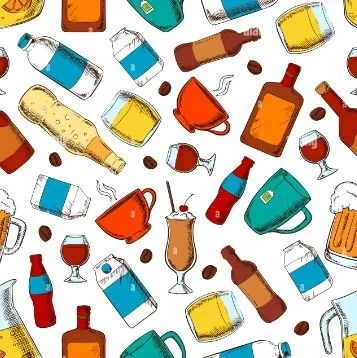Have a Drink
Beverages—we all enjoy them in one way or another, but did you ever stop to think that maybe we didn’t always partake in these rituals and luxuries as human beings? People look at me like I’m from outer space when they want to know what I like to drink and I say water. Animals drink water, but humans consume beverages which are considered drinks that provide calories, vitamins, minerals, and/or neurological effects such as alcohol and caffeine.
Although humans, as Homo sapiens, have been around for 300,000 years, the Modern Beverage Era only began about 12-15,000 years ago. Archaeologists and anthropologists denote this point in our history as when humans began producing and consuming beverages other than water and there’s plenty of scientific evidence to back their speculations.
Take a guess at what the oldest known beverage is and how long we’ve been consuming it.
If you said milk, you’d be correct. If you said beer, you also might be correct as an assortment of evidence points to both emerging about the same time in Mesopotamia, now modern-day Iran, Iraq, Syria, and Turkey. These include clay tablets with inventory records for dairy herds and microscopic milk proteins found in skeletons’ dental plaque.
Whoever came up with the idea of consuming the milk of other species tipped the scales in favor of Neolithic humans as the Vitamins C and D allowed migration into less sunny latitudes that did not produce the fruits and vegetables needed to sustain a healthy population.
Although not as nutritious as milk, beer offered the advantage of sanitizing water, the intoxicating effects being a bonus. Ancient Sumerian texts dating from 6,000 BCE listed nearly twenty different types of beer being brewed in vessels that look remarkably similar to modern-day fermentation vats. As much as 40% of the region’s grain production went into making beer.
Fermenting technologies migrated north to the fruit belt and wine production was next to emerge. Sites in Georgia (the country, not the state) have been dated as far back as 8,000 years ago. Like beer production, wine is also a way to remove harmful bacteria from water.
Anytime you have fermentation and beverage storage taking place you’re going to find empties. We’ve got bottles and cans today. They had clay pots. Not just any clay pot, mind you, but ones with narrow necks for stoppering and storing. Once again, modern microscopy revealed yeasts, fungi, and gelatins along with traces of assorted flavorings such as ginger.
In China, over 5,000 archaeological sites have been identified as ancient breweries dating far ahead of tea, which only began to be cultivated and consumed 4,700 years ago.
Here’s one I didn’t expect—lemonade. People began making and consuming sweetened lemon water—actually, all citrus approximately a thousand years ago in Cairo. Anyone who has ever been to Egypt knows how refreshing a cool drink of lemonade can be.
The new kid on the block is coffee, making its way on to our beverage cart in the 15th century in Ethiopia. Coffee lore is that the effects of the beans were discovered when a goat herder noticed his goats becoming animated after eating coffee beans. I start my day with a cup of Yirgacheffe.
The berry bush spread throughout the region becoming widely cultivated throughout Persia, Egypt, Syria, and Turkey.
Scientists are digging deeper into our consumption of beverages prior to the advent of pottery. By examining our genetic makeup they’ve found that we’ve been drinking milk for at least 20,000 years by dating the genes that produce lactase, the enzyme needed to digest milk. We may not have been farming livestock for milk production on a large scale, but genes tell us we’ve been drinking milk for a very long time.
Walking around the market one can find all of these beverages is assorted forms. From fluid milk, cheeses, and yogurts to modern concoctions like Peach Clementine Lemonade Iced Tea it’s a stroll through history and antiquity each week.

